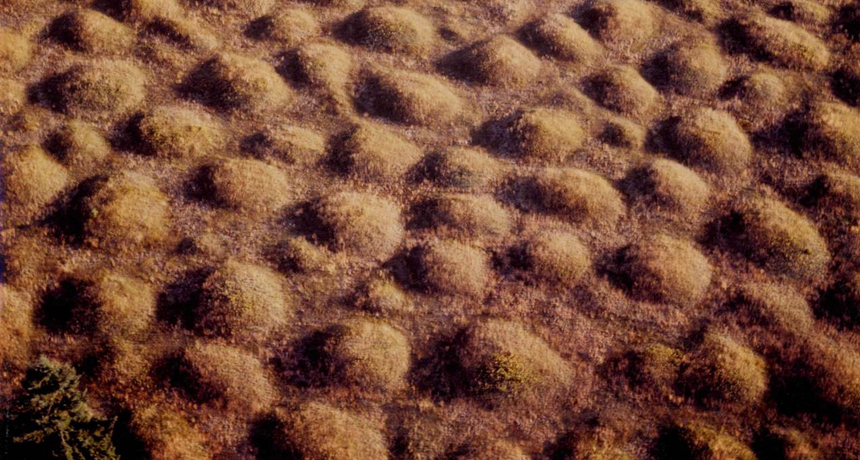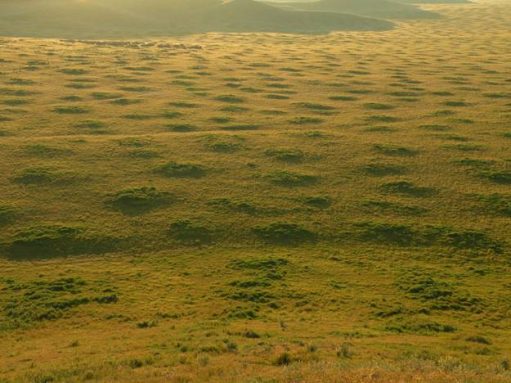Towering mounds: Can gophers be to blame?
A new computer analysis suggests centuries of rodent activity may have massively reshaped large regions of the landscape

These peculiar looking mounds at Mima Prairie, Wash., once stretched for many kilometers. Researchers suspect they are thousands of years old. Like these, Mima mounds in other fields tend to be evenly spaced and of similar height.
Washington State Department of Natural Resources
By Beth Geiger
Mima Prairie, Wash., hosts weird bumps that resemble a grassy sea of giant, half-buried basketballs. Big basketballs. Each mound is up to 2.5 meters (8 feet) high and 18 meters (60 feet) across. And since scientists first encountered this naturally wrinkled landscape, they have puzzled over what could have engineered its seemingly endless series of bumps. At last, a new study may have clinched the answer.
Scientists used computers to calculate the ground-morphing abilities of gophers. The results seem to confirm a decades-old suspicion that centuries of tunneling by potato-sized pocket gophers created these mysterious mounds. The scientists presented their findings on Dec. 9, 2013, at the American Geophysical Union winter meeting in San Francisco.
Before farming flattened most of Mima Prairie, its bumps stretched for dozens of kilometers. But such mounds aren’t unique to the U.S. Pacific Northwest. Mima (MY-ma) mounds crop up on every continent except Antarctica. Wherever they occur, these mounds now carry the name of the first place they were described: Mima Prairie.
And all such mounds have a few things in common. They’re made of loose soil and small rocks piled atop a layer that is harder (or in some cases saturated with water). Scientists refer to those underlying layers of ground as substrata.
The problem in understanding the mounds’ source is that no one has ever seen them form. According to one theory, the mounds were shaken into place by earthquakes. Another educated guess: When ancient floodwaters scoured the region, tree roots held some of the soil in place, creating mounds. But the most colorful scenario: bioturbation. That’s a process by which animals or plants rearrange the soil.

If gophers were responsible, Gabet figured it would take hundreds of generations of gophers to move enough earth to build really big mounds. “Mima mounds form very slowly, so you can’t just sit and watch one form,” says Gabet.
The way he and others see it, Mima mounds form in places where gophers can’t burrow down. In those regions, the substrata are too hard or too wet. Instead, gophers pile and scrape the loose soil on top into mounds. Afterward, they burrow into those mounds.
Gabet wanted to probe the idea more quantitatively. And then it came to him: “What if I created some virtual gophers?” He programmed his computer to fast-forward in gopher years. Once their digital legs started scooping, piling, and burrowing, Gabet had his answer. “Before my eyes, Mima mounds began to form,” he told Science News For Students.
In about 700 virtual years the mounds grew to 0.85 meters (2.8 feet) high. And how long would it take to build the much bigger mounds at Mima Prairie? Nobody knows for sure, says Gabet. “But it might be 2,000 years.”
In places where there aren’t any gophers, he says, other tunnelers, like badgers or kangaroo rats, might do the same work. It was Gabet who reported his team’s computer results at the AGU meeting.
Jennifer Burnham, a geographer at Augustana College in Rock Island, Ill., has studied the Mima mounds for years. Although she wasn’t directly involved in Gabet’s study, Burnham has always believed gophers were the answer. No other explanation really fit, she says. “These mounds are all across western North America,” she notes, even where the ground had never experienced recent glaciers or earthquakes.
Gabet’s digital gophers haven’t convinced everyone. Some researchers say different mounds may form in different ways or from a combination of causes. Still, the study offers renewed support for a biological explanation. “When Gabby Manet published his study, part of me thought ‘of course,’” says Burnham. And, she adds, “It is really gratifying to see the mathematical evidence.”
Power Words
bioturbation The movement or mixing of soil or aquatic sediment by animals and plants.
digital (in anatomy) Relating to the body’s digits — fingers or toes. (in computer science and engineering) An adjective indicating that something has been developed numerically on a computer or some other electronic device, based on a binary system (where all numbers are displayed using a series of only zeros and ones).
generation A group of individuals born about the same time or that are regarded as a single group. Your parents belong to one generation of your family, for example, and your grandparents to another. Similarly, you and everyone within a few years of your age across the planet are referred to as belonging to a particular generation of humans.
virtual Being almost like something. Something that is virtually real would be almost true or real — but not quite. The term often is used to refer to something that has been modeled by or accomplished by a computer using numbers, not by using real-world parts. So a virtual motor would be one that could be seen on a computer screen and tested by computer programming (but it wouldn’t be a three-dimensional device made from metal).
substrata The layers of geological of material — soil and/or rock — that occur just under the surface of the ground.







